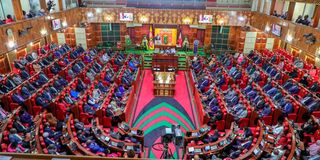How Kenya’s protest ban is being smuggled into law

The National Assembly during a past session.
In democratic societies, the right to protest is not just symbolic. It is fundamental. It is the mechanism through which citizens voice dissent, demand accountability, and shape the direction of their nation. Yet in Kenya, this right is now under calculated assault.
Not by outright constitutional amendment, but through a quiet, technical modification of distance. A single sentence buried within the proposed Public Order (Amendment) Bill is poised to do what decades of autocracy could not fully achieve: make street protests in Kenya’s political heart logistically and legally impossible.
The amendment, deceptively benign in its language, introduces a ban on public gatherings within 100 metres of what it defines as “protected areas.” These areas include institutions of immense national significance: Parliament, the Office of the President, the National Treasury, the Supreme Court, police headquarters, and others that remain undefined.
While 100 metres may sound minor or procedural, in urban Nairobi, where these institutions sit in close proximity, this restriction becomes a strategic death blow to civic resistance. These exclusion zones will quickly overlap, fusing into a vast no-go zone in the very spaces where protest matters most. This isn't legislation aimed at curbing violence or chaos. It's not about maintaining peace.
It’s about denying visibility. It's about criminalising proximity. Once the amendment passes, Nairobi's Central Business District, the symbolic and physical epicentre of political accountability, will be transformed into a fortress, not by barricades, but by invisible perimeters drawn with rulers and fear. In these new zones, standing silently with a placard will be treated with the same suspicion as inciting violence. Citizens won't be judged by what they do, but by where they stand.
Democracy
This is not public order. This is spatial repression. A cartographic strategy to suppress dissent by mapping fear onto public space. It is the weaponisation of geography to disempower citizens, and it strikes at the very heart of democracy. Because protest is not just about words, it is about presence.
A demonstration at the gates of Parliament carries a different political and psychological weight than one hidden in a park two kilometres away. The government understands this. That’s why it seeks to render protest inaudible. Not by banning it outright, but by pushing it so far from power that it loses its sting.
Under the guise of protecting institutions, the state is drawing circles around our freedoms. And those circles are not neutral. They can be expanded, redefined, and manipulated at will. What starts as 100 metres from Parliament today can become 300 metres from a county office tomorrow. Once the precedent is set that physical proximity to power is criminal, the map of repression can grow unchecked.
The danger here is not just legal, but psychological. When you criminalise position instead of conduct, you shift the burden from action to location. Guilt becomes spatial. Dissent becomes logistical. The very act of showing up becomes an offence. The chilling effect is profound. Citizens begin to self-censor, not because they no longer care, but because they can no longer find a legal place to stand.
This is the silent genius of the amendment. It does not need to shut down the streets with police brutality, though Kenya has a history of doing just that. Instead, it outsources repression to cartography. You do not need a dictator to ban protests when a legislature can redraw the map. And because this law does not mention speech, flags, or chants, it gives the illusion of legality while dismantling the core infrastructure of public pressure.
The right to protest near the seat of power is not a privilege to be granted or withdrawn by politicians. It is a foundational element of democratic citizenship. It is how we say no, how we demand better, how we remind those in office that sovereignty belongs to the people. When that right is fenced off by overlapping technicalities and polite legalese, what we are witnessing is not the enforcement of order. It is the erosion of democracy, hidden in footnotes and distance clauses.
There is a bitter irony here. Kenya’s political elite rose to prominence through movements that relied on mass action, street protests, and civil resistance. They know the power of protest because they once wielded it. Now, safely ensconced in power, they seek to close the very roads they once marched on. They seek to build a democracy that tolerates elections but fears protest. A democracy of ballots without voices, of voting without gathering, of grievance without location.
If this amendment passes, it will mark not just a legal shift, but a moral turning point. It will be the moment the state chose to silence not by censorship, but by distance. And the greatest danger is that it will seem normal. That Kenyans will begin to believe that the right to protest is something to be negotiated block by block, building by building, rather than something that inheres in every citizen by virtue of being free.
We must not let this pass quietly. This is not a minor amendment. It is the architecture of fear, drafted in meters, enforced by silence. Protest must be heard where power lives. Not exiled to the margins of the city or the constitution. Otherwise, democracy becomes a performance, and the people, its rightful authors, mere spectators fenced out of their own story.
Gitobu Imanyara is an Advocate of the High Court, Publisher & Editor in Chief of The Platform for Law, Justice & Society


